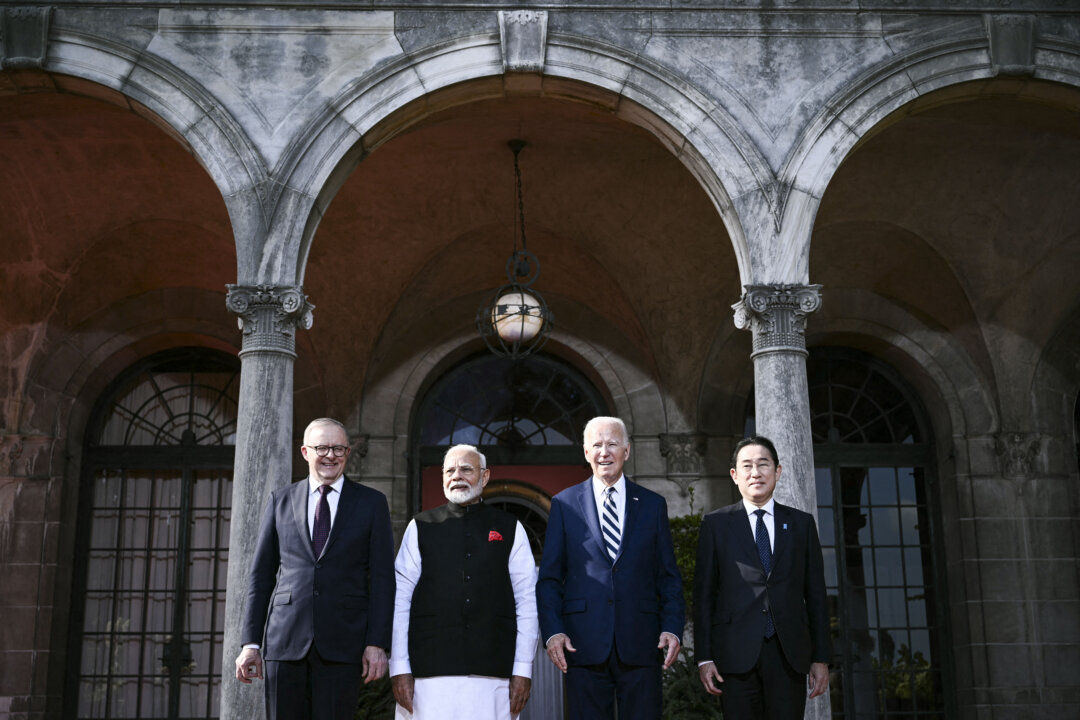New cooperation between the United States, Australia, Japan, and India is largely focused on containing China.
The leaders of the Indo-Pacific Quadrilateral partnership (Quad)—the United States, Australia, Japan, and India—announced new efforts on Sept. 21 to boost their shared maritime security capabilities and expand other areas of regional cooperation.
President Joe Biden hosted the fourth in-person Quad Leaders Summit in Wilmington, Delaware, on Sept. 21 to discuss a range of topics concerning the four nations, including ways to enforce international law in the waterways of the Indo-Pacific.
Ahead of the summit, the White House announced that the Quad partners will soon begin their first joint coastguard exercises that will become a rotational training effort. The United States will lead the first round of the joint training, with Australian, Japanese, and Indian personnel coming aboard a U.S. Coast Guard vessel to pick up and exchange skills.
The White House announced that the Quad will also expand its existing Indo-Pacific Partnership for Maritime Domain Awareness (IPMDA) initiative. The IPMDA aims to increase transparency about maritime activity in the region and how nations may be asserting their various claims in the Indo-Pacific waterways, providing awareness not only to the Quad members but also to other regional partner nations.
The four-way Quad partnership has the potential to serve as a check on the expansionist pursuits of the Chinese Communist Party, but its members have avoided announcing any quadrilateral military alliance that could one day face war with the communist party if it moves to enforce its model of governance in the region. The United States has instead pursued separate bilateral alliances and security partnerships more specifically positioned to respond to hostilities in the region.
US–Australia
Biden met with Australian Prime Minister Anthony Albanese on the evening of Sept. 20 for a bilateral discussion ahead of the main Quad meeting. In their post-meeting readouts, Biden and Albanese both emphasized the centrality of the shared values of the U.S.–Australia alliance to relations between their two countries. They both alluded to a “depth of cooperation” on defense and security, economic ties, and climate and clean energy initiatives.
According to the White House readout, the two leaders discussed their support for maintaining peace throughout the Taiwan Strait. The Taiwanese people govern themselves independently of the Chinese mainland. But the People’s Republic of China considers the island, also known as the Republic of China, as part of its territory despite there being no formal peace treaty to end the Chinese Civil War in 1949. Since the 1970s, the United States has favored a strategically ambiguous status quo on the question of who should control Taiwan.
“The leaders discussed their respective diplomacy with the People’s Republic of China (PRC) and their shared concerns about the PRC’s coercive and destabilizing activities, including in the South China Sea,” the White House readout of the Biden–Albanese meeting reads.
US–Japan
Biden next met with his Japanese counterpart, Prime Minister Fumio Kishida, on the afternoon of Sept. 21 for a second bilateral discussion.
“The President praised the Prime Minister’s visionary and courageous leadership over the past three years, which has fundamentally enhanced Japan’s defense capabilities and transformed its role in the world,” a White House readout reads. “He thanked the Prime Minister for his resolute support for strengthening Alliance defense cooperation, including on command and control, defense industrial cooperation, and enhanced exercises and training, and for advancing a free and open Indo-Pacific region.”
The White House stated that Biden and Kishida “reiterated their resolve to maintain peace and stability across the Taiwan Strait and underscored their opposition to any attempts to change the status quo by force.”
Biden also thanked Kishida for being willing to grow ties between his nation and South Korea, allowing for an expanding trilateral partnership that could prove useful in reinforcing the regional status quo.
The United States and Japanese leaders also discussed shared efforts to develop and protect critical technologies such as semiconductors and artificial intelligence, two areas of growing competition with communist China.
US–India
The White House published a joint fact sheet with Indian Prime Minister Narendra Modi’s administration on Sept. 21, highlighting existing U.S.–India cooperation on a range of issues, including defense technology and space exploration. The fact sheet noted India’s plans to procure MQ-9 Reaper drones, and a U.S.–Indian partnership to help maintain India’s fleet of C-130J Super Hercules military cargo aircraft.
The White House also published a roadmap laying out a U.S.–Indian clean energy initiative. The roadmap describes a plan to expand manufacturing of solar and wind energy components.
The roadmap calls for directing about $1 billion in new multilateral financing through the International Bank for Reconstruction and Development to help expand India’s domestic clean energy supply chain.
“Over time, we seek to mobilize additional financing into priority clean energy manufacturing sectors that harness public and private financial tools and pioneer innovative financial vehicles to meet the rapid demand for flexible climate finance solutions,” the White House document reads.
Another objective of this U.S.–India clean energy roadmap is to identify ways to expand supply chains for clean energy components. The roadmap also entails working with African partner nations on new solar and electric vehicle projects.

